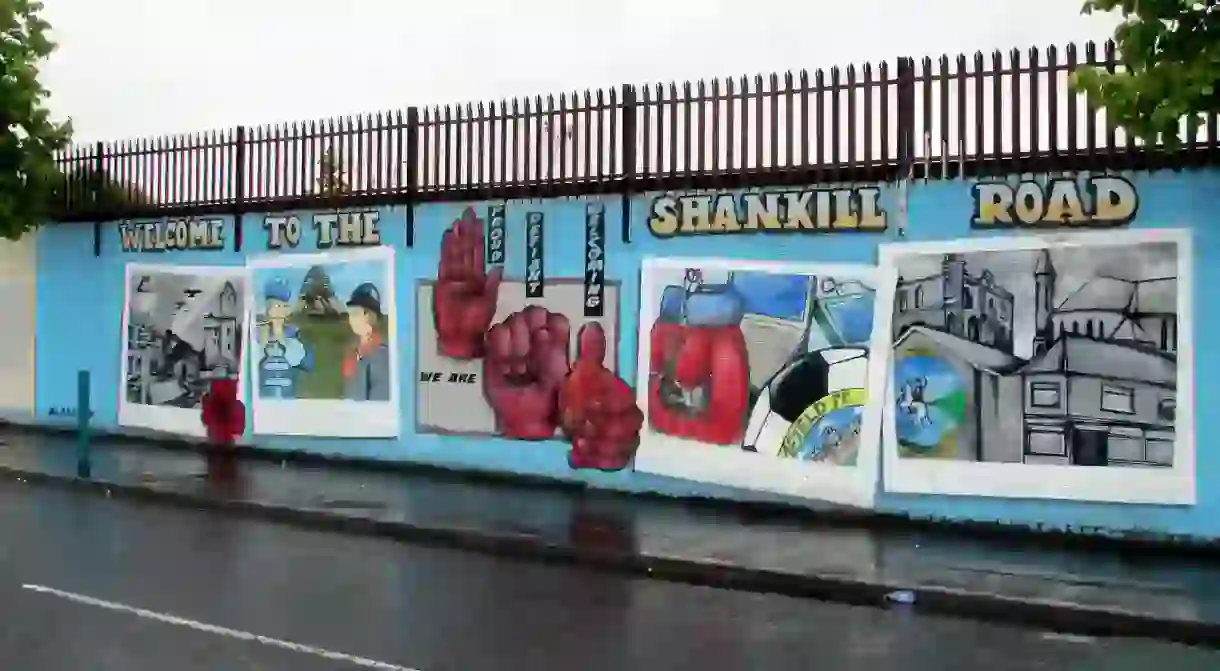How Did the Shankill Road Become Northern Ireland’s Most Notorious Street?

The Shankill Road is one of the most famous roads in Belfast, and it’s easy to see why. Along with the neighbouring Falls Road, it dominates the West of the city. Together, the two roads saw a large proportion of the sectarian violence Belfast experienced during the Troubles. In a calmer era now, here’s our brief history of the Shankill Road.
Ancient history
The Shankill Road is actually named for a church which stood there as early as the 5th century. Known as ‘The Church of St Patrick of the White Boy’, it was a site of pilgrimage and was clearly important enough to name the area. Seanchill is Irish for ‘old church’, so clearly, the church had been around for a while before the name! The River Farset flowed past the church, a river that was once hugely important to Belfast, even giving the city its name – Beal Feirste, Irish for the Mouth of the Farset. Now, however, it flows through a tunnel under the city’s High Street.

Paving the way
As a defined road, the Shankill dates to the 16th century when it formed part of the main road to Antrim. Like many other sections of Belfast, the area saw growth during the 19th century when Belfast’s linen industry boomed. People can see the influence of the linen industry in the names of the area’s smaller streets, many of which are named after Belgium, as the country was the source of the flax for the linen. Brussels Street, although hidden in the cobweb of side streets, is probably the best example of this trend.
However, the prosperity that the linen industry brought to Belfast was city-wide, not at all limited to the Shankill area. The Falls Road transformed from a small lane into a heavily populated district in its own right. This area, though, was dominated by an Irish Catholic population, while the Shankill remained Protestant and Unionist. The large-scale Catholic migration to the largely Ulster Protestant Belfast led to sectarian rioting across the city, with the Falls and Shankill areas often finding themselves at the centre of the conflict. In the early 20th century, the Ulster Volunteer Force – a militia dedicated to blocking Home Rule for Ireland – met on the Shankill.

The Troubles
During the Troubles, tensions between the two streets did nothing but grow. The loyalist paramilitary Ulster Volunteer Force (UVF) emerged in the middle of the 1960s, positioning themselves as the direct successors to the original UVF, although there is no direct link between the two. In 1966, the group petrol bombed (Molotov cocktails) a Catholic-owned pub on the Shankill. This attack was their first, and it proved unsuccessful when the building next door also caught fire, killing Matilda Gould, a 77-year-old Protestant woman.

One of the escalations of sectarian violence during the Troubles took the form of the loyalist gang known as The Shankill Butchers, who were responsible for at least 23 murders between 1975 and 1982. Many of the gang members were part of the UVF, and the group was best known for the kidnapping and murder of suspected Catholics. On top of the 15 Catholics the group murdered, they also killed six Protestants after personal disputes, and two Protestant men sitting in a lorry who the group mistook for Catholics.
Another loyalist paramilitary, the Ulster Defence Association (UDA) emerged on the street in 1971 when several smaller vigilante groups decided to combine their efforts. Because it was home to so many loyalist paramilitaries, the Shankill Road and the larger Shankill area was a popular target for Irish republican paramilitary efforts, with several attacks on pubs and one fish shop bombing.
The fish shop bombing, known as The Shankill Road Bombing, occurred in 1993 and is one of the most well-known single incidents of the Troubles. The Provisional IRA attempted to assassinate the UDA leadership, who were due to meet above Frizzell’s fish shop. The plan had been to evacuate customers and plant a time bomb with a short fuse, but the bomb exploded prematurely, killing eight civilians and one of the two bombers. Regardless, unbeknownst to the bombers, the meeting had ended early, and the attendees had already left the building.

Future
In August 1994, the PIRA declared a ceasefire, and six weeks later, in October, the Combined Loyalist Military Command (a group composed of the UVF, UDA, and Red Hand Commando) declared their own ceasefire. In 1998, the Good Friday Agreement was passed, which is generally regarded as the end of the Troubles. Although Northern Ireland has still not completely recovered from its past, conflict no longer dominates the city. Indeed, the city’s famous black taxi tours now travel routes that would once have been dangerous, taking tourists to see the city’s murals, historical sites, and peace walls, many of which are along the Shankill and Falls Roads.














